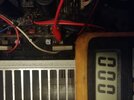sfoxon
New Member
Hello Hive Mind!
I have the Denon PMA-350se power Amplifier, which has some distortion on the LH channel only. I have been playing with Sine waves and probing with the Oscillsope, but am limited in what I can do. A service manual with circuit diagrams can be found: edit: Thank you for pointing out no link: https://www.vintageshifi.com/repertoire-pdf/pdf/telecharge.php?pdf=Denon-PMA-350-Service-Manual.pdf
I last pick up a clean sine wave before the Volume pot. Between the volume pot and the Big Transistors on the heat sink, I cannot pick up a signal, as probing changes the sound and the readout is very dirty. At input to the big transistors, the sine wave is showing distortion. So somewhere between volume and bridge rectifier essentially.
The good news is I can share the distortion with you:

This looks like rectifier crossover distortion! and YET I have replaced: The main transistors (TR361-4), main smoothing caps (C003-4), DC blocking caps (C327-8), more caps C013-4 and C324-5 and also the OpAmp Chip. All to no avail.
What next?
I have the Denon PMA-350se power Amplifier, which has some distortion on the LH channel only. I have been playing with Sine waves and probing with the Oscillsope, but am limited in what I can do. A service manual with circuit diagrams can be found: edit: Thank you for pointing out no link: https://www.vintageshifi.com/repertoire-pdf/pdf/telecharge.php?pdf=Denon-PMA-350-Service-Manual.pdf
I last pick up a clean sine wave before the Volume pot. Between the volume pot and the Big Transistors on the heat sink, I cannot pick up a signal, as probing changes the sound and the readout is very dirty. At input to the big transistors, the sine wave is showing distortion. So somewhere between volume and bridge rectifier essentially.
The good news is I can share the distortion with you:
This looks like rectifier crossover distortion! and YET I have replaced: The main transistors (TR361-4), main smoothing caps (C003-4), DC blocking caps (C327-8), more caps C013-4 and C324-5 and also the OpAmp Chip. All to no avail.
What next?
Last edited:



